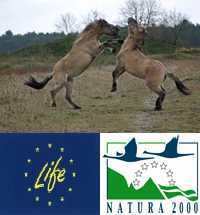 Bildrechte: NLWKN
Bildrechte: NLWKNAnimal and Plant Species in the Project Area
Within the LIFE project area numerous animal and plant species have been identified, among them many endangered species that are on the so-called Red List. We will now give a brief introduction to the species inventory of some selected groups.
Birds:
Between April and August 2006, the breeding birds living on open land and those living at the edges of forests in the project area were counted. Four comprehensive checks were performed by the NLWKN nature conservation centre Unterelbe. A number of supplementary checks of part areas were contributed by Bernd Letto (landscape warden of the city of Cuxhaven) and Wilhelm Lemke (NABU Cuxhaven).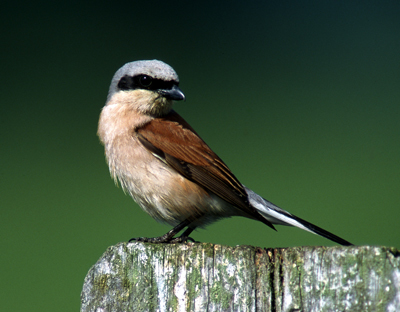 Bildrechte: Schaffhäuser
Bildrechte: SchaffhäuserThe most common bird species in open heath areas and at the forest edges were skylarks, tree pipits and yellowhammers. There is a significant population of all three species in the area. The table below shows the mapping result of 2006 for some characteristic bird species of open land.
|
Species |
RL-G |
RL-LS |
Number of P/T |
Density |
|
|
Sky lark |
Alauda arvensis |
N |
3 |
115 |
19,8 |
|
Tree pipit |
Anthus trivialis |
N |
N |
90 |
15,5 |
|
Yellowhammer |
Emberiza citrinella |
55 |
9,5 |
||
|
Whitethroat |
Sylvia communis |
19 |
3,3 |
||
|
Stonechat |
Saxicola torquata |
3 |
8 |
1,4 |
|
|
Woodlark |
Lullula arborea |
3 |
2 |
5 |
0,9 |
|
Red-backed shrike |
Lanius collurio |
3 |
3 |
0,5 |
|
|
Nightjar |
Caprimulgus europaeus |
2 |
2 |
1-2 |
0,3 |
P/T = Pairs per Territory, 2 = strongly endangered, 3 = endangered, N = Near endangerment.
RL-G = Red List, Status Germany.
RL-LS = Red List, Status Lower Saxony.
To date 73 species of breeding birds and 88 species of migrant birds have been identified.
Reptiles and Amphibians:
For these two species groups, no current systematic mappings have been carried out. During the evaluation of results for the newly created small ponds, a detailed list of amphibians in the existing and new ponds as of 2007 will be compiled.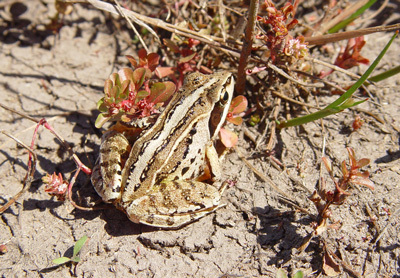 Bildrechte: NLWKN
Bildrechte: NLWKNThe following species have been confirmed in the LIFE project area:
|
Species |
RL-G |
RL-LS |
|
|
Sand lizard |
Lacerta agilis |
3 |
3 |
|
Viviparous lizard |
Lacerta vivipara |
||
|
Blindworm |
Anguis fragilis |
||
|
European adder |
Vipera berus |
2 |
3 |
|
European toad |
Bufo bufo |
||
|
Moor frog |
Rana arvalis |
2 |
3 |
|
Common water frog |
Rana kl. esculenta |
||
|
Common newt |
Triturus vulgaris |
||
Locusts:
To date, locusts have not been systematically researched in the LIFE project area. Due to the prevailing heaths and lean turf the inhabitants of open, dry and warm habitats are dominant.The relatively large population of the wart-biter cricket deserves special mention.|
Species |
RL-G |
RL-LS |
|
|
Lesser marsh grasshopper |
Chorthippus albomarginatus |
||
|
Duetting grasshopper |
Chorthippus biguttulus |
||
|
Field grasshopper |
Chorthippus brunneus |
||
|
Tetered grasshopper |
Chorthippus mollis |
N |
|
|
Meadow grasshopper |
Chorthippus parallelus |
||
|
Stripe-winged grasshopper |
Stenobothrus lineatus |
3 |
|
|
Common green grasshopper |
Omocestus viridulus |
||
|
Mottled grasshopper |
Myrmeleotettix maculatus |
||
|
Sort-winged conehead |
Conocephalus dorsalis |
3 |
|
|
Great green bush-cricket |
Tettigonia viridissima |
||
|
Bog bush-cricket |
Metrioptera brachyptera |
||
|
Wart-biter cricket |
Decticus verrucivorus |
3 |
2 |
Dragonflies:
Despite the very few ponds and streams in the LIFE project area, the city of Cuxhaven proved in the years 2004-2006 to have a species-rich dragonfly fauna with 25 species of dragonflies and a large number of specialised species.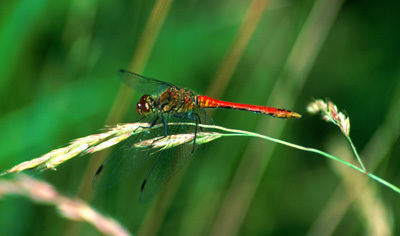 Bildrechte: Scherer
Bildrechte: SchererThe dragonfly fauna is particularly species-rich in the marshland of the "Menyanthes-Sumpf" (17 species) and near the "Fasanerie" area (20 species). During the evaluation of results for the newly created small ponds, the compilation of a list of dragonflies in the existing and new ponds will be intensified as of 2007.
|
Species |
RL-G |
RL-LS |
|
|
Emperor dragonfly |
Anax imperator |
||
|
Southern hawker |
Aeshna cyanea |
||
|
Brown hawker |
Aeshna grandis |
N |
|
|
Common hawker |
Aeshna juncea |
3 |
3 |
|
Migrant hawker |
Aeshna mixta |
||
|
Subarctic darner |
Aeshna subarctica |
1 |
2 |
|
Small red damselfly |
Ceriagrion tenellum |
1 |
1 |
|
Northern damselfly |
Coenagrion hastulatum |
3 |
3 |
|
Azure damselfly |
Coenagrion puella |
||
|
Variable damselfly |
Coenagrion pulchellum |
3 |
|
|
Downy emerald |
Cordulia aenea |
N |
|
|
Common blue damselfly |
Enallagma cyathigerum |
||
|
Blue-tailed damselfly |
Ischnura elegans |
||
|
Scarce emerald damselfly |
Lestes dryas |
3 |
2 |
|
Emerald damselfly |
Lestes sponsa |
||
|
Green emerald damselfly |
Lestes viridis |
||
|
White-faced dragonfly |
Leucorrhinia dubia |
2 |
3 |
|
Northern white-faced darter |
Leucorrhinia rubicunda |
2 |
3 |
|
Broad-bodied chaser |
Libellula depressa |
||
|
Four-spotted chaser |
Libellula quadrimaculata |
||
|
Large red damselfly |
Pyrrhosoma nymphula |
||
|
Black darter |
Sympetrum danae |
||
|
Yello-winged darter |
Sympetrum flaveolum |
3 |
|
|
Ruddy darter |
Sympetrum sanguineum |
||
|
Vagrant darter |
Sympetrum vulgatum |
||
In addition, an older observation of Leucorrhinia pectoralis exists from the Moorschlatt area near Altenwalde. However, this species has not been confirmed there for several years.
Vascular Plants:
Within the framework of the biotope and habitat cataloguing under the Habitats Directive, performed in the LIFE project area in 2006, the vascular plants and especially the growth areas of endangered groups were mapped.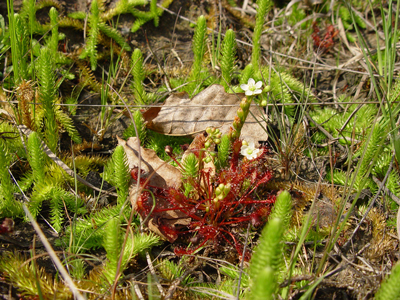 Bildrechte: NLWKN
Bildrechte: NLWKNThe list of plants consists of 189 species, but it can be assumed that this list is not yet complete.
|
Species |
RL-G |
RL-LS |
Pop.-Size |
|
|
Bog-rosemary |
Andromeda polifolia |
3 |
3 |
6 |
|
Arnica |
Arnica montana |
3 |
2 |
(6) |
|
Vernal water-starwort |
Callitriche palustris |
3 |
6 |
|
|
Marsh marigold |
Caltha palustris |
3 |
3 |
|
|
Wooll-fruit sedge |
Carex lasiocarpa |
3 |
3 |
8 |
|
Carnation sedge |
Carex panicea |
3 |
7 |
|
|
Little green sedge |
Carex viridula var. viridula |
N |
3 |
|
|
Heath spotted-orchid |
Dactylorhiza maculata |
3 |
3 |
5 |
|
Spoonleaf sundew |
Drosera intermedia |
3 |
3 |
6 |
|
Round-leaved sundew |
Drosera rotundifolia |
3 |
3 |
6 |
|
Many-stalked spike-rush |
Eleocharis multicaulis |
2 |
2 |
7 |
|
Petty Whin |
Genista anglica |
3 |
3 |
7 |
|
Silky leaf woadwaxen |
Genista pilosa |
3 |
3 |
|
|
Marsh Gentian |
Gentiana pneumonanthe |
3 |
2 |
3 |
|
Coral necklace |
Illecebrum verticillatum |
3 |
3 |
8 |
|
Common juniper |
Juniperus communis |
3 |
2 |
|
|
Marsh Clubmoss |
Lycopodiella inundata |
3 |
3 |
6 |
|
Bogbean |
Menyanthes trifoliata |
3 |
3 |
6 |
|
Sweet gale |
Myrica gale |
3 |
3 |
6 |
|
Bog asphodel |
Narthecium ossifragum |
3 |
3 |
7 |
|
Royal fern |
Osmunda regalis |
3 |
3 |
6 |
|
Lousewort |
Pedicularis sylvatica |
3 |
2 |
6 |
|
Bog pondweed |
Potamogeton polygonifolius |
3 |
3 |
6 |
|
Yello rattle |
Rhinanthus minor |
N |
2 |
|
|
White beak-sedge |
Rhynchospora alba |
3 |
3 |
7 |
|
Brown beak-sedge |
Rhynchospora fusca |
2 |
2 |
8 |
|
Viper's grass |
Scorzonera humilis |
3 |
2 |
2 |
|
German deergrass |
Trichophorum cespitosum ssp. germanicum |
3 |
3 |
5 |
 Bildrechte: NLWKN
Bildrechte: NLWKN- LIFE Nature Project
- Project Sponsors and Financing
- Project Goals
- Project Organisation
- Location and Size
- Usage History
- Geology and Soils
- Biotope and Habitat Types
- Animal and Plant Species
- Project of National Significance
- Natura 2000, Nature Reserve
- Heck Cattle and Konik Horse Grazing
- Wisent Grazing
- Small Ponds
- Development of Forests Suited to the Location
- Removal of Small Trees and Shrubs
- Information for Visitors
Artikel-Informationen
Ansprechpartner/in:
Hannah Burmester
Nds. Landesbetrieb für Wasserwirtschaft, Küsten- und Naturschutz
Betriebsstelle Lüneburg
Adolph-Kolping-Str. 6
D-21337 Lüneburg
Tel: +49 (0)4131 2209-221


